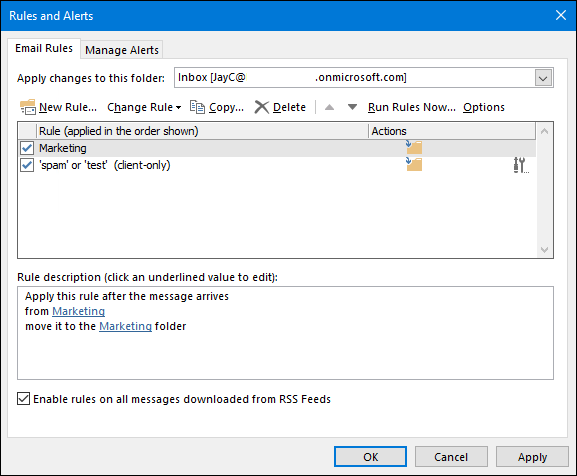

In short context, rules are there for you to use to keep your email inbox just the way you want it. Lines, such as “You have Won the Lottery!!!”. They can also be used to stop spam, as you can set a rule to block specific emails with particular subject Rules can be used to place emails from set senders within folders, or with set subject lines.

What are rules, and how can they be used?
#How to create a rule for outlook 2016 for pc how to#

To fix that and import your rules, click “Options”. Open the “Rules and Alerts” dialog box in one of the two ways we discussed earlier. Let’s import those rules you created and backed up, so Outlook can automatically take action on email as it comes in. Now, say you’ve set up your new computer, installed Office, imported the Outlook data file you backed up (rules are not saved in Outlook data files) from your old computer, and you’re ready to check email. RELATED: Beginner: How to Maintain, Archive, and Back Up Your Data in Outlook 2013 rwz file to any external or network drive or share it with other people. Once you’ve exported your rules file, click “OK” on both the “Options” and “Rules and Alerts” dialog boxes to return to the main Mail screen (or the “Account Information” screen, depending on where you started). NOTE: If you’re sharing your rules with multiple people using different older versions of Outlook, select the earliest version, because older rules files can always be opened in newer versions of Outlook. Select one of those options as needed, and then click “OK” to save the rules file. In addition to the rules file format for the current version of Outlook, the “Save as type” drop-down list provides three additional formats for the rules file, for people who are still using Outlook 2002, 2000, or 98. If you’re sharing your rules file with someone using an older version of Outlook, you’ll need to select a different type of rules file before you save the file, as discussed below. If you’re sharing your rules with other people using the same version of Outlook as you, click “Save”.

rwz extension is automatically added to the file. The “Rules Wizard rules (*.rwz)” type is selected by default in the “Save as type” drop-down list and the. Enter a name for your backup file in the “File name” edit box. Navigate to the folder in which you want to save your rules backup file. The “Save Exported Rules as” dialog box displays. On the “Options” dialog box, click “Export Rules”. NOTE: All the rules listed here will be backed up, not just selected rules. On the “E-mail Rules” tab, click “Options” on the toolbar above the list of rules you’ve created. The “Rules and Alerts” dialog box displays.


 0 kommentar(er)
0 kommentar(er)
